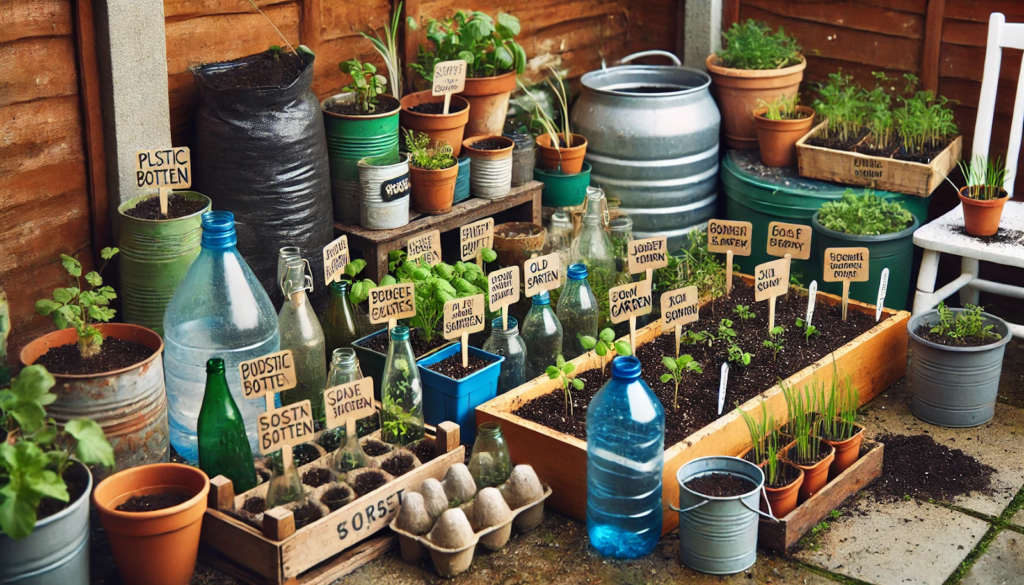You don’t need a big budget or fancy tools to start a beautiful and productive garden. With a bit of creativity, resourcefulness, and patience, you can grow flowers, herbs, and even vegetables with little to no financial investment.
This guide will show you step-by-step how to start a garden with no money—using recycled materials, free resources, and natural techniques.
1. Use What You Already Have
Start by taking inventory of materials you already own. You might be surprised at how many useful gardening items are sitting unused in your home.
Look for:
- Old buckets, containers, or crates (can become pots or planters)
- Plastic bottles or yogurt tubs (great for seed starting)
- Wood scraps or bricks (ideal for raised beds or borders)
- Old spoons or popsicle sticks (for plant labels)
- Leftover food scraps (for composting)
2. Source Free Containers
You don’t need expensive pots. Plenty of free options can be found with a little effort.
Try:
- Asking at restaurants or grocery stores for used food containers
- Using old coffee cans, tin cans, or milk jugs
- Repurposing shipping boxes or egg cartons for seedlings
- Upcycling wine boxes or drawers into planter boxes
Just make sure to poke holes in the bottom for drainage.
3. Make Your Own Compost
Compost is the best free fertilizer and soil builder you can get—and it’s easy to make.
Start a basic compost pile using:
- Vegetable scraps
- Fruit peels
- Coffee grounds
- Eggshells
- Grass clippings
- Dry leaves
Avoid meat, dairy, and oily foods to prevent odors and pests.
You can compost in a bin, an old bucket, or just a corner of your yard.
4. Get Free Seeds and Plants
Seeds don’t have to cost a dime if you know where to look.
Where to Find Free Seeds:
- Seed swaps: Join local gardening groups or online communities
- Library programs: Some libraries have free seed exchanges
- Harvest your own: Save seeds from grocery store produce (e.g., tomatoes, peppers, herbs)
- Ask friends or neighbors: Many gardeners have extra seeds or cuttings
Pro Tip: Dry and label your seeds clearly for use next season.
5. Propagate Plants from Kitchen Scraps
Many vegetables and herbs can regrow from scraps or cuttings.
Examples:
- Green onions: Place root ends in water and watch them regrow.
- Lettuce and celery: Grow new plants from the base in shallow water.
- Garlic cloves: Plant individual cloves to grow new bulbs.
- Basil and mint: Root cuttings in water and transfer to soil.
6. Build Garden Beds with Free Materials
Raised beds can be built using salvaged materials.
Free Building Material Ideas:
- Old pallets
- Bricks or stones
- Logs or branches
- Cardboard (as a weed barrier beneath your soil)
Tip: Always check for safe, untreated wood to avoid chemicals leaching into your soil.
7. Collect Rainwater
Why pay for water when nature provides it for free?
How to Get Started:
- Set out clean buckets or tubs during rainfall
- Use an old barrel or trash can to make a rain barrel
- Attach a basic diverter to your gutter
Rainwater is free and better for plants than chlorinated tap water.
8. Use Natural Fertilizers
Chemical fertilizers can be expensive—and unnecessary.
Free Fertilizer Ideas:
- Compost tea: Soak compost in water for a liquid plant booster
- Banana peels: Rich in potassium and phosphorus
- Crushed eggshells: Add calcium and deter pests
- Grass clippings: Mulch that feeds the soil
Avoid over-fertilizing—many plants thrive in simple, organic soil.
9. Garden with the Seasons
Gardening in sync with nature reduces cost and increases success.
Tips:
- Plant cool-season crops like lettuce, spinach, and peas in spring and fall
- Grow warm-season crops like tomatoes and squash in late spring/summer
- Use succession planting to make the most of your space
Check your USDA planting zone for specific dates.
10. Join Community Gardening Efforts
Many communities offer shared garden spaces and free resources.
Look for:
- Community garden plots (often free or low-cost)
- Gardening workshops and free supply days
- Local Facebook groups or Nextdoor listings
These resources often include compost, tools, and advice from experienced gardeners.
Bonus: DIY Gardening Tools
If you don’t have garden tools, make your own or improvise.
- Trowel: Use a kitchen spoon
- Watering can: Punch holes in a milk jug lid
- Plant labels: Use popsicle sticks, flat stones, or broken pottery
- Soil scoop: Cut the bottom off a plastic bottle
Gardening on a Zero-Dollar Budget Is Possible
You don’t need a fancy setup to grow something beautiful and useful. With resourcefulness and intention, you can build a thriving garden that feeds your family and nourishes your soul—without spending a dime. Nature provides everything you need. You just have to get started.






